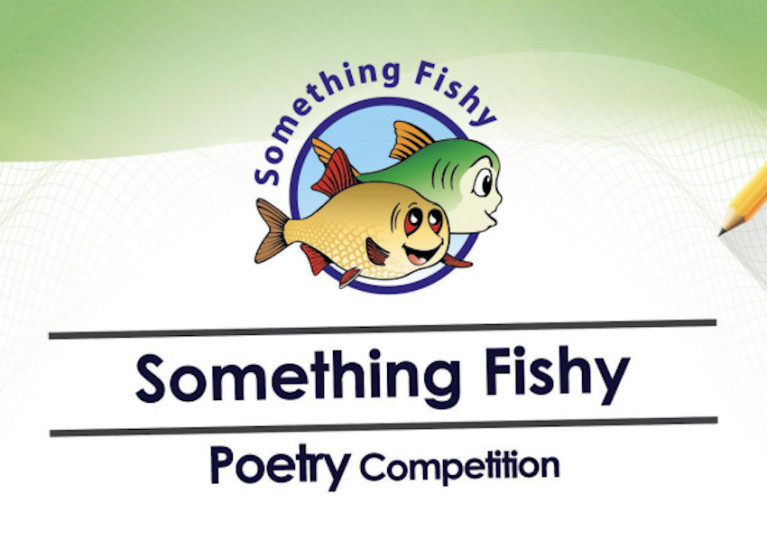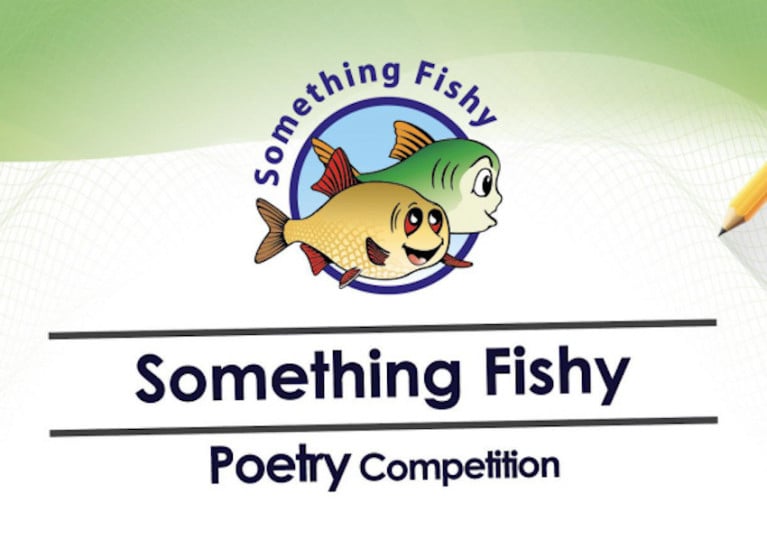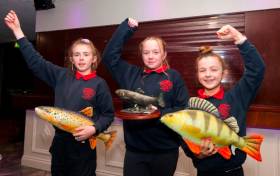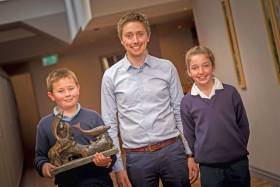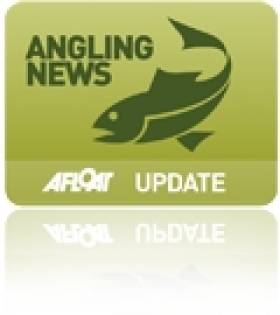Displaying items by tag: Something Fishy
A primary school in Sligo has reeled in the winning prize in Inland Fisheries Ireland’s (IFI) Something Fishy competition for 2023.
Something Fishy is an educational programme aimed at primary school pupils aged between 10-13 years old. It informs and educates students on fish, water, angling and the Irish environment.
Sixth class learners at Scoil Mhuire agus Iosaf in Collooney, Co Sligo created the winning project in this year’s competition, and received a €500 prize voucher to be used for educational purposes at the school.
On completion of the programme, primary school students were challenged by IFI to create a project to demonstrate their learnings based on the theme of ‘life along the river’.
Scoil Mhuire agus Iosaf pupils’ project was based on a visit to the Unshin River in Riverstown, and the life cycle of Atlantic salmon for whom the river and its tributaries are an important area for spawning.
Their project took the form of a large 3D papier mâché sculpture showing the river in two contrasting states — healthy and unhealthy — with clay salmon to illustrate the different stages of their life cycle and how it interacts with the environment.
Announcing the winners, Suzanne Campion, head of finance and corporate services at IFI said: “This winning project showcased a great level of awareness from these young Sligo students of biodiversity in and around our rivers. A big thanks to Sligo Education Centre for their assistance with schools in the Sligo area.
“It is reassuring to see the knowledge that these children have on issues around the conservation and protection of our fisheries resource. Such interest and engagement on the sustainability of our fish and habitats bodes well for future generations — who will, after all, be the custodians of our inland fisheries in the years to come.”
This year 45 schools participated in the Something Fishy initiative, which is organised by IFI in conjunction with Blackrock Education Centre.
Primary School Artists Reel In Top Prizes in ‘Something Fishy’ National Poster Competition
Two young artists from Cork and Dublin have scooped the winning prizes in the 2022 Something Fishy national poster competition, with a third student from Laois being awarded the Special Judges’ Category prize.
The competition, which is organised by Inland Fisheries Ireland (IFI) in conjunction with Blackrock Education Centre, received artistic entries from across the country.
Madelena Duggan, a sixth-class pupil from Ardfield National School in Clonakilty, Co Cork and Emma Kilmurry, a fifth-class pupil from Sacred Heart School, Clondalkin, Co Dublin each won in their category for their conservation-themed poster.
While Katie O’Neill, a sixth-class pupil from Presentation Portarlington Primary School, Portarlington, Co Laois won the Special Judges’ Category prize.
 Madelena Duggan, 6th class winner, Ardfield National School, Clonakilty, Cork
Madelena Duggan, 6th class winner, Ardfield National School, Clonakilty, Cork
Earlier this year, as previously reported on Afloat.ie, primary school students around the country were challenged by IFI to create a poster with the ‘catch-photo-release’ (CPR) message that could be used in awareness campaigns.
Announcing the winners, Suzanne Campion of IFI said: “We received a host of beautiful posters containing important conservation-based messaging. It is reassuring to see the level of awareness that today’s young people have on issues around conservation and protection of our fisheries resource.
“Engagement in these issues early on is promising for future generations to be active stewards over our inland fisheries and the surrounding environment.”
The overall winners will receive a tablet to the value of €500 each and the winner of the Special Judges’ Category will receive a tablet to the value of €200.
 Emma Kilmurry, 5th class, Sacred Heart School, Clondalkin, Dublin
Emma Kilmurry, 5th class, Sacred Heart School, Clondalkin, Dublin
Niamh Murray, director of Blackrock Education Centre added: “It was fantastic to see the number of entries in this year’s Something Fishy competition. I was incredibly impressed by the standard of artwork created by the young people. They are all winners as far as I am concerned!
“It is also greatly encouraging to witness young people wanting to be involved in environmental issues and the competition was a perfect way to harness this interest. The future looks very good with such committed, environmentally aware young people. Their artwork will go on to feature in awareness campaigns nationally on fish conservation.”
The national poster competition is an important element of the wider Something Fishy Educational Programme, aimed at primary school pupils aged between ten and thirteen. It educates students on the importance of biodiversity and on having sustainable habitats, fish and angling. Information about the programme is available from somethingfishy.ie
Primary School Artists Wanted to Help Promote Conservation in 2022 ‘Something Fishy’ Contest
Fifth and sixth class pupils around the country are being asked to design a poster that encourages greater conservation of Ireland’s native fish.
Organised by Inland Fisheries Ireland (IFI) in conjunction with Blackrock Education Centre, the national poster competition is part of the Something Fishy educational programme and officially kicks off this month.
The winning posters will be used as part of an awareness campaign to promote the ‘catch, photo and release’ (CPR) method of angling in Ireland.
Under the CPR approach, a fish that is caught with a rod by an angler is quickly photographed and then returned safely back into the same water to swim away.
As a result, greater numbers of fish can be conserved in rivers, lakes and around coastlines, putting less pressure on fish populations and boosting biodiversity.
To enter, primary school students are being asked to create a poster with the ‘catch, photo and release’ message, take a photograph of it and then submit it by email before the closing date of Friday 15 April.
The winning students in the fifth and sixth class categories will receive a tablet to the value of €500 and will have their work featured in an awareness campaign.
In 2021, IFI and the Blackrock Education Centre ran a national poetry competition, with two young poets from Tipperary and Carlow scooping the top prizes.
To enter the 2022 competition, parents, guardians or teachers are asked to email original entries to [email protected] before Friday 15 April. Only one entry is allowed per pupil and all winners will be announced in early June.
Free resources with further details about the competition are available from www.somethingfishy.ie
Two young poets from Tipperary and Carlow respectively have scooped the top prizes in this year’s Something Fishing national poetry competition, organised by Inland Fisheries Ireland (IFI) in conjunction with the Blackrock Education Centre.
Orlaith Timmons, a fifth-class pupil from Moycarkey National School in Thurles, and Aoibhé Kieran, a sixth-class pupil from Ballon National School in Carlow, each won the top prize in their categories for their nature-themed poetry.
Earlier this year, primary school students around the country were challenged by IFI to create an acrostic poem, where the first letter of each line spells out the word ‘STREAM’ (for an English-language poem) or ‘SRUTH’ (for an Irish-language poem).
Announcing the winners, Environment Eamon Ryan said: “These are gorgeous poems that really capture the joy these young people are experiencing spending time in nature. I’d like to congratulate all our budding young poets on their achievements this year.
“Through this environmental competition, primary school children have shown huge enthusiasm for nature, fish, other wildlife and the world around us. Improving our children’s knowledge and understanding of biodiversity, through initiatives like this one, will be an important part of our climate action efforts.”
The competition is part of the wider Something Fishy Educational Programme, aimed at primary school pupils aged between 10 and 13. It educates students on the importance of biodiversity and on having sustainable habitats, fish and angling.
Despite school closures during the 2020/2021 academic year, online content was still available to pupils and teachers through the official website at somethingfishy.ie including lesson plans and activity sheets based on the theme of the life cycle of salmon — bradán as Gaeilge.
From over 100 entries, the judging panel also selected runners-up from Ballon National School and Bennekerry National School (Carlow), Scoil Mhuire National School in Corofin (Galway), Scoil Cholmcille in Greencastle (Donegal) and St Canice’s Girls National School in Finglas (Dublin).
Praising the young winners and their schools, Suzanne Campion, IFI’s head of business development, said: “By researching and writing about fish, wildlife and rivers from an early age, primary school children are learning really important lessons about biodiversity and how we all have a role to play in protecting and conserving our environment.
“Congratulations to all our winners and our thanks to everyone who took part in this year’s competition. I’d also like to thank all the teachers, principals and school staff who supported the Something Fishy programme and competition over the last year.”
The overall winners will receive a fishing kit to the value of €100 and runners-up will receive an outdoor field trip kit to the value of €50. Third-placed winners and special category winners will receive goody bags.
“This year we received fantastic entries from budding poets and nature enthusiasts. With a total of 114 entries in the competition for its second year running, it is encouraging to see the interest amongst young people across Ireland,” said Dr Susan Gibney, director of the Blackrock Education Centre.
“Competitions like this not only help with student’s literacy skills but also expands their knowledge of the biodiversity that exists around them in our lakes and rivers.”
All winning poems from the 2021 Something Fishy national poetry competition can be read at somethingfishy.ie/schools
National Schools Competition Once Again Fishing for Young Poets
Primary school pupils across Ireland are once again being asked to get poetic as the Something Fishy poetry competition returns for 2021.
Started last year by Inland Fisheries Ireland and the Blackrock Education Centre to keep pupils engaged while out of the classroom during coronavirus restrictions, the contest asks school children to write a short verse about fish and their environment.
This year, however, the poem must be an acrostic, in which the first letter of each line spells out a word — in this case ‘STREAM’.
Pupils are also encouraged to illustrate their poems with their own artwork to complete their submissions across three categories — fifth class, sixth class and Irish language — and be in with a chance to win some great prizes.
These prizes include fishing kits to the value €100 and outdoor field trip kits worth as much as €50.
Suzanne Campion, head of business development at Inland Fisheries Ireland, said: ‘We are delighted to launch this competition for the second year in a row and we are looking forward to seeing the imaginative works the young poets create.
“There are lots of fun and interactive resources available on www.somethingfishy.ie to help inspire budding poets.”
Only one entry is permitted per student and it is to be original work. The closing date for entries is Friday 28 May.
Parents/guardians are being asked to email the entry to [email protected] and to include the student’s name, class (5th or 6th) and school name and address.
The winning illustrated poems will be chosen by a panel of judges, and winners will be announced on Friday 18 June.
Winners Announced In ‘Let’s Fish’ National Poetry Competition
Six young poets have been selected as winners of the ‘Let’s fish’ national poetry competition which took place earlier this summer.
The contest was organised by Inland Fisheries Ireland in conjunction with the Blackrock Education Centre, to keep pupils engaged while out of the classroom during coronavirus restrictions.
Entries were received from across Ireland under the title ‘Let’s fish’, with pupils encouraged to research the Something Fishy online resource and asked to write a five-line poem on the topic.
And the poems revealed how much fish and fishing means to our younger generation, IFI says.
In the Fifth Class category, Oran from CBS Primary School in Dundalk took first prize, followed by Ethan of Scoil Naomh Buithe in Monasterboice, Co Louth and Philip of Scoil Réalt na Mara in Tuosist, Co Kerry.
Meanwhile, Millie of St Patrick’s NS in Greystones, Co Wicklow placed first in the Sixth Class category, while second prize went to Leah of Sion Mills Primary School in Co Tyrone and third to Dara from Scoil Phadraig in Westport.
IFI says it will share the winning entries across its social media platforms over the coming weeks.
Doora National School from Ennis, Co Clare has been named winner of Inland Fisheries Ireland’s (IFI) national Something Fishy contest for 2019.
The students from sixth class were presented with the Something Fishy perpetual trophy by Pat Breen TD, Minister of State for Trade, Employment, Business, EU Digital Single Market and Data Protection, at Treacys West County Hotel in Ennis yesterday (Monday 25 November).
Doora National School received the national accolade after being commended for their Something Fishy blog project, which saw them complete artwork on the life cycle of a salmon, report on a field trip they took with local fisheries officers and produce an exercise book.
The blog was accessible to their peers and members of the public on Somethingfishy.ie with a view to sharing their learning experiences and to increasing awareness of their fisheries resource in the local community.
It followed months of engagement by the students in the education programme which saw them work with IFI’s Fisheries Officers from the Shannon River Basin District to learn about their local fisheries resource.
The winners were chosen to go forward to represent their region by Clare Education Centre in June.
During the 2018-2019 academic year, 104 national schools and 12 education centres took part in the fisheries education programme which reached over 2,000 students across the country.
As part of Something Fishy, students learn about fish and the environment, enjoying classroom based activities as well as a practical field trip with fisheries officers. The Something Fishy programme is an initiative of IFI in partnership with Blackrock Education Centre.
Speaking about the Something Fishy award, Minister Pat Breen said it “is particularly special as we celebrate the International Year of the Salmon in 2019, an initiative which hopes to raise awareness around the different challenges that face the Salmon species today”.
‘The level of creativity, passion for learning and enthusiasm shown in their project stood out’
IFI chief executive Dr Ciaran Byrne said: “The students and teachers of Doora National School submitted an impressive project for assessment. The level of creativity, passion for learning and enthusiasm shown in their project stood out and deserves recognition at this national level.
“We would like to thank Clare Education Centre and our partners in Blackrock Education Centre for their support in bringing the programme to the high standard that it is today.”
Ross Darmody, teacher of the winning class in Doora National School, said: “We are proud of the students here at Doora National School for their inspiring enthusiasm to engage with and learn about the fisheries environment and its species.
“The programme is cross-curricular and draws together geography, science and ICT as well as ensuring that the learning is fun for everyone through the interactive online ‘Something Fishy’ resources.
“As a school we look forward to working with Inland Fisheries Ireland again in the future to bring this programme to even more students.”
Letterkenny School Nets Top Prize In 2018 ‘Something Fishy’ Competition
Letterkenny Educate Together National School has been named winner of the national education programme Something Fishy for 2019.
The students from fifth class were presented with the Something Fishy perpetual trophy and a monetary prize by Minister for Education Joe McCue at their school yesterday (Monday 19 November).
The pupils received the national accolade for their project called Save Our Schools (SOS), which saw the class build a website aimed at engaging other children and young people to learn about fish and the importance of protecting the fisheries resource for angling and inland fishing.
The webpage included digital games and video content, all devised and produced by the children themselves.
During the 2017-2018 academic year, 99 national schools and 10 education centres took part in the Something Fishy programme, reaching some 3,000 students.
The Something Fishy education programme is an initiative of Inland Fisheries Ireland, in partnership with Blackrock Education Centre, which allows students to learn about fish and the environment in a local context.
Students enjoy classroom-based activities as well as practical field trips with fisheries officers as part of the programme, which is promoted and delivered by education centres nationwide. In addition, students compile and submit projects on their learning for assessment by an independent judging panel.
Teachers and students participating in the Something Fishy programme explore eight different lessons on the fisheries resource, after which they receive a visit from inland fisheries Oofficers who introduce them to their local river and the fish and invertebrates who live within in. Since its inception in 2005, over 50,000 students have participated in the programme.
Minister McHugh said: “This year’s award is particularly special as we embark, in conjunction with countries all over the world, on the International Year of the Salmon to celebrate the shared cultural and mythological place of salmon in societies around the globe.
He added: “I am particularly proud that Donegal, and especially the Letterkenny area, has built up an excellent pedigree in this competition with this year’s champions following in the footsteps of Gartan NS who won the title last year.”
Inland Fisheries Ireland chief executive Dr Ciaran Byrne said: “Letterkenny Educate Together really impressed the judging panel with their use of digital communications to highlight significant conservation messages for their peers. I would like to congratulate the children and their teachers, Nakita Burke and Cliona Marley, for showcasing important learnings about the local fisheries environment in such an effective manner.”
Jacqui Dillon, director of Donegal Education Centre, said the county’s second win in two years “is reflective of the commitment of the teachers involved and the keen interest they have engendered in their pupils”.
Salmon Life Cycle Video Nets ‘Something Fishy’ Prize For Sligo Pupils
#SomethingFishy - Pupils at Scoil Chroí Naofa in Bunninadden, Sligo have been named the national winners of Inland Fisheries Ireland’s Something Fishy competition for 2016 at an event in Sligo’s Clarion Hotel yesterday (Wednesday 12 October).
The winning group of 24 children from the school’s senior class take home the National Something Fishy Award and €700 for their animated short on the life cycle of the salmon – selected by an independent judging panel comprising fisheries officers and education staff.
Along with their teacher Adrian Ormsby, the class edited and produced the digital and artistic photo story during the previous school term.
The ‘Something Fishy’ programme is an educational initiative of Inland Fisheries Ireland (IFI) in partnership with Blackrock Education Centre, which allows students to learn about fish and the environment in a local context.
The 2016 programme saw 3,776 children taking part in 118 schools and 11 education centres nationwide. Students were invited to submit project entries into the competition with this year’s entries addressing the theme ‘Focus on Learning’.
“The standard of entry to this year’s Something Fishy competition was particularly high and it is fantastic to have so many children engaged on our fisheries resource,” said IFI chief executive Dr Ciaran Byrne.
“Something Fishy gives children an opportunity to learn valuable lessons about the importance of protecting and conserving the aquatic environment but perhaps more importantly, they are also empowered to share their learnings with their peers via digital projects which can be enjoyed by all.”
Bernie Burke, principal of Scoil Chroí Naofa, described the win as “a fantastic achievement by the students involved who have thoroughly enjoyed taking part in the programme.
“They have discovered the magical world within our waterways and enjoyed learning all about the aquatic environment. I would like to congratulate each of them and their teacher Mr Ormsby on all their hard work.”
Since the inception of Something Fishy in 2005, some 50,000 children have participated in the initiative which aims to promote interest and understanding in fish and their habitats.
As part of the educational programme, IFI fisheries officers visit schools and provide classroom-based assistance, with a full range of resources for teachers and children also available on the Something Fishy website.
Together, they explore the themes of fish, habitats, angling, water environment and the protection and conservation of Ireland’s rivers and lakes.
Aside from school-based learning, fisheries officers take students into the field to give them some practical experience of their work.
Longford Pupils Win Something Fishy 2014 With 'Angling At One'
#Angling - Fifth and sixth class pupils from St John’s National School in Longford have been named national winners of the Inland Fisheries Ireland’s (IFI) Something Fishy competition for 2014 for their class project ‘Angling at One’.
At a prize giving ceremony held yesterday (17 October) in Carrick on Shannon Education Centre, the Longford primary pupils were awarded for their self-made interpretation of RTÉ’s Live at One, featuring quiz shows, music, dance, arts and cooking, all related to angling, rod and line fishing, as well as the role of IFI.
Joanne Bowers, Principal, St John’s NS principal Joanne Bowers was presented with the perpetual trophy by Marian Harkin MEP. “I am delighted to accept this award on behalf of the students of St John’s National School in Longford, who have demonstrated an extraordinary degree of creativity, organisation and technical know-how, in their creation of their winning project," she said.
“I would like to thank the staff of Inland Fisheries Ireland, who supported the delivery of the Something Fishy educational programme at St John’s, including highly engaging presentations and field trips which really made the subject of angling and conservation of rivers and lakes come to life for the students.”
The competition has been running since 2005 nationwide and this year over 130 schools took part, reaching almost 4000 individual students.
Something Fishy is an educational resource originally designed and promoted by the Central and Regional Fisheries Boards, now Inland Fisheries Ireland, in conjunction with Blackrock Educational Centre.
Speaking at yesterday's event, IFI chief executive Dr Ciaran Byrne said: “Something Fishy is something that IFI is extremely proud to be a part of. In a typical year, we bring the programme to around 100 schools across the country. And every year our staff are amazed by the willingness of the children to learn, and their passion for our inland fisheries resource.”
Those addressing the attendees at yesterday's event included Anna Feely, chair of Carrick on Shannon Education Centre; Catherine Martin, director of Carrick on Shannon Education Centre; and Pat Seaver Director of Blackrock Education Centre – all educationalists who applauded the high production standards of St John’s NS’s winning project.




























